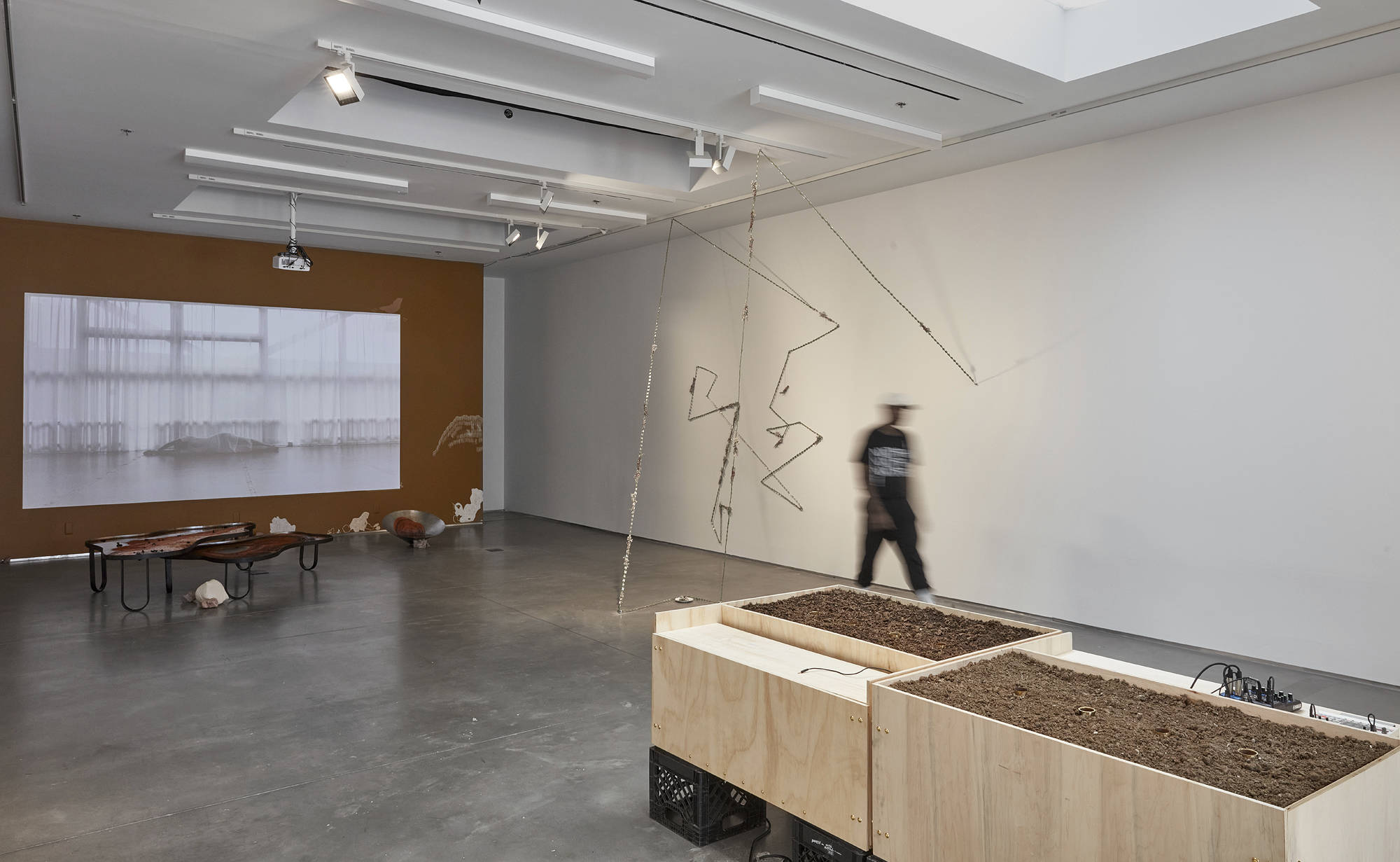
Arts & Culture | Arts, Culture & Community
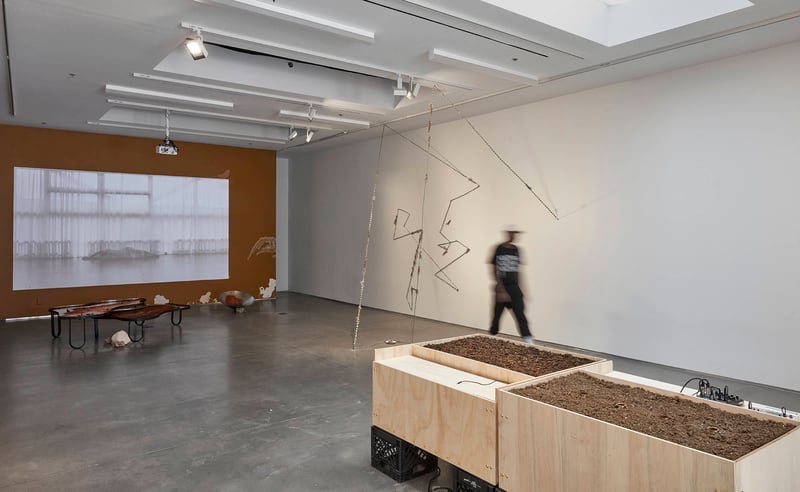
Photos by Chris Gardner/Courtesy NXTHVN.
Lungiswa Gqunta’s quiet voice, pierced by a few soft coughs, narrates a dream as the artist slowly rolls along the clean floor of a large empty room. Spoken in isiXhosa, Gqunta’s words from the video projection fill the back half of NXTHVN’s gallery as she fills her chest with air. She raises her arms above her head, and her body tumbles closer to the viewer before exiting the shot, arms still outstretched overhead, as if bound by the wrist.
Framed within a white rectangle on a wall painted an earthy ocher, this video is part of the installation With my softness I carve mountains—one of two works by Gqunta on view at the Dixwell arts institution through May 19 in the group exhibition, To Echo a Shadow. In front of the video are two curved pieces of steel containing pools of water that disappear and reappear throughout the exhibition. The water leaves a residue of rust—its freshest parts tinged a brilliant orange with dark brown edges. The natural drawing left by this chemical process presents a way to consider movement, tapping into the show’s broader theme of enforced passages.
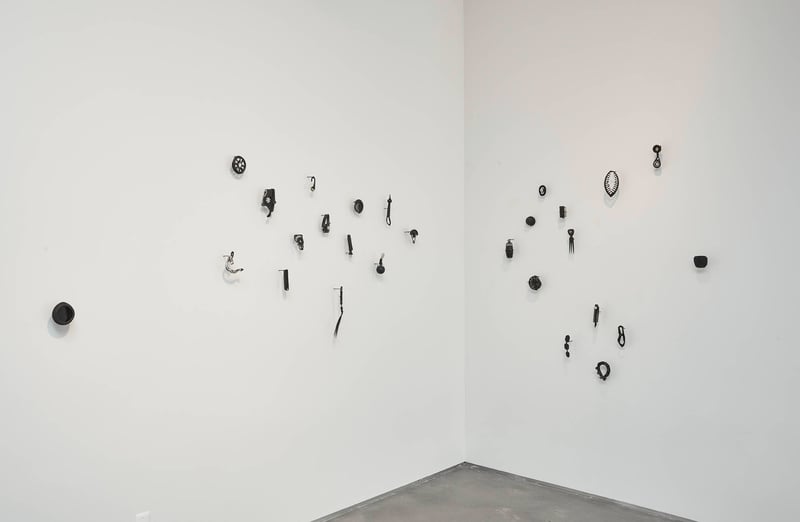 Curated by Marquita Flowers and Clare Patrick, NXTHVN’s Cohort 05 Curatorial Fellows, To Echo a Shadow stresses the sense of sound as a seminal aspect of forced migration in the wake of industrialization. Sounds—including oral storytelling traditions and music—may travel easily from one place to another, though their paths are often nonlinear. In this show, jointly Flowers and Patrick have brought together four artists, two of whom engage with music, noise, or sounds directly.
Curated by Marquita Flowers and Clare Patrick, NXTHVN’s Cohort 05 Curatorial Fellows, To Echo a Shadow stresses the sense of sound as a seminal aspect of forced migration in the wake of industrialization. Sounds—including oral storytelling traditions and music—may travel easily from one place to another, though their paths are often nonlinear. In this show, jointly Flowers and Patrick have brought together four artists, two of whom engage with music, noise, or sounds directly.
The emphasis on sound begins outside the entrance to the gallery, where the curators have created a listening space. A shelf of vinyl records from jazz musicians who played at Lillian’s Paradise and the Monterey Club can be played on a record player in the atrium. These two former venues in the Dixwell neighborhood of New Haven hosted notable jazz artists such as John Coltrane, Duke Ellington, Billie Holiday, and Charles Parker—all represented here.
Also among the curated album selection is Johnny “Hammond” Smith’s “Black Coffee,” a 1962 recording of a performance at the latter location. This gesture highlights the local jazz history while underscoring the significance of music and sound as a form of expression. As a time-based medium, music is inherently immaterial. Sounds cannot be erased or removed as they move.
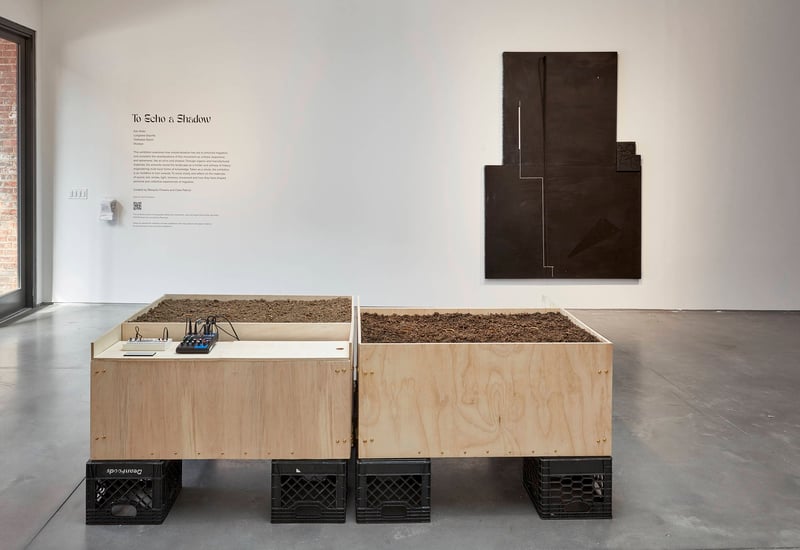 Stepping back inside the gallery, Ash Arder’s Broadcast #4 presents a stage awaiting activation. Two large plywood boxes on black milk crates contain rich brown soil—some from Detroit where the artist works and some from a local plant nursery. Beneath the damp earth are speakers pumping a rhythmic thud into the space, competing with the soft sounds of Gqunta’s video on the back wall.
Stepping back inside the gallery, Ash Arder’s Broadcast #4 presents a stage awaiting activation. Two large plywood boxes on black milk crates contain rich brown soil—some from Detroit where the artist works and some from a local plant nursery. Beneath the damp earth are speakers pumping a rhythmic thud into the space, competing with the soft sounds of Gqunta’s video on the back wall.
The title of Arder’s plays on the double meaning of the word “broadcast”—connoting both the transmission of sound and, within the field of agriculture, a method of spraying seeds. Mostly hidden from view, brass pipes attached to the speakers hold collard green seeds, perhaps another connection to forced migration: West African women braided rice seeds into their hair before boarding ships to the Americas and present-day Brazil during the Middle Passage.
Like seeds scattered across a large bed, Oluseye’s Eminado series stages an arrangement of small objects pinned on two of the gallery’s walls. What unites these items—27 in total—is their color: a matte black so pure its contrast appears stark against the white backdrop. Culled from Canada, Mexico, Mozambique, and Nigeria, among other locations, Oluseye’s talisman are combinations of found forms: wisps of fake hair, the end of an electrical plug, and one loop from a pair of scissors, among other pieces. These juxtapositions are sometimes dotted with a cream-colored cowrie shell—a material that reappears in the Nigerian-Canadian artist’s Good Luck Totem outside the doors to the space.
This “Diasporic debris,” Oluseye’s term for the collection, is logged into a database mapping the items and locations of the remnants as they are discovered. These artifacts reveal the things that get left behind, logging instances of a society unconcerned with waste.
On an adjacent wall, Indeterminacy #3 (Black Compositional Thought) by Torwkase Dyson, an interdisciplinary artist who has been invited to participate in this year’s Whitney Biennial, also foregrounds the color black. On two canvas panels so thick they become sculptural, Dyson blends a formal investigation of composition while conjuring specific instances of bodily contortion, particularly the story of Henry Brown’s infamous liberation via the mail. In 1849, Brown traveled 350 miles, crammed inside a wooden crate smaller than most contemporary dishwashers, arriving the next day at the home of William Johnson, a Philadelphia member of the Underground Railroad.
The scale of Indeterminacy #3 and its murky veils of dark paint invite viewers—or those able to make the leap from the abstract painting to this historical narrative—to imagine the light-less discomfort of Brown’s journey toward freedom. Dyson’s practice infuses Blackness into her abstractions, often monumental in scale. These large works relate to the scale of a body and speak to movement, or as the artist put it: “freedom is an ongoing spatial question of motion and imagination.”
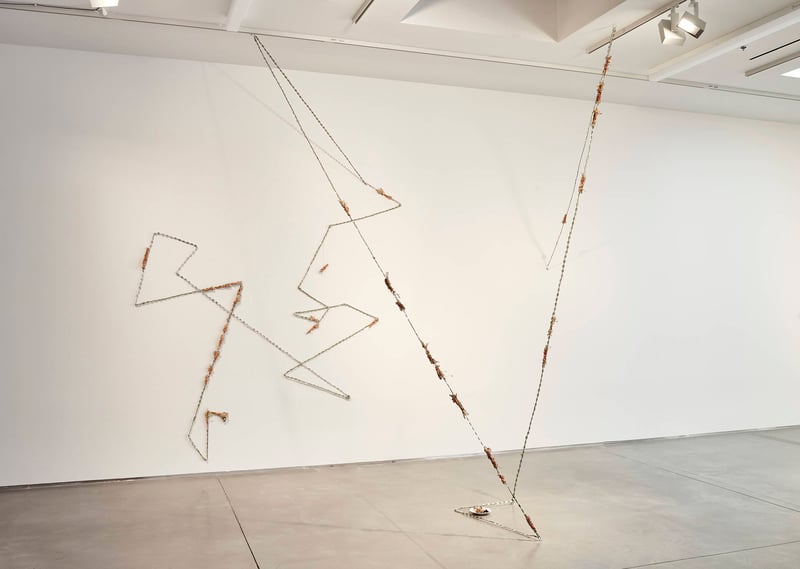 While Dyson’s work may heighten a visitor’s awareness of safety or danger, another installation by Gqunta brings the threat of real harm into the gallery. The most notable material present in Benisiya Ndawoni (Return to the Unfamiliar)—a line drawing that meanders from the floor to the ceiling, to a rambling path on the wall, and back again—is razor wire. Wrapped in a green fabric with frayed edges, the razor wire has bundles of sage and imphepho (a plant indigenous to South Africa and used as a cleansing salve), tied to the wire with thin, red threads.
While Dyson’s work may heighten a visitor’s awareness of safety or danger, another installation by Gqunta brings the threat of real harm into the gallery. The most notable material present in Benisiya Ndawoni (Return to the Unfamiliar)—a line drawing that meanders from the floor to the ceiling, to a rambling path on the wall, and back again—is razor wire. Wrapped in a green fabric with frayed edges, the razor wire has bundles of sage and imphepho (a plant indigenous to South Africa and used as a cleansing salve), tied to the wire with thin, red threads.
Razor wire is used in domestic settings in Cape Town, where the artist lives, whereas in the United States, this material is more often employed as a deterrent. Sparkly and foreboding, this installation adds the concept of barriers—both physical and contrived—to the exhibition’s meditation on migration.
Taken as a whole, To Echo a Shadow relies on sounds and sculpture, stoked with ritualistic elements. The repetitive binding of fabric around sharp glittering edges, the persistent throb of a low sound, and the gentle murmuring voiceover in the video offer visitors a meditative mind space. With poetry and poignancy, the show focuses on the people and things moving great distances around this earth but does not ignore the sometimes vile reasoning behind these pathways. If a shadow had a sound, it would be a whisper, and like this show, its soft reverberations would remain embedded in your ears.

